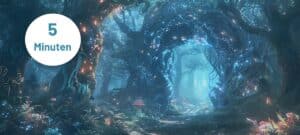First things first:
- It was written around 1200
- The author remains unknown.
- It belongs to the heroic epic genre.
- It is often referred to as a German national epic.
- It consists of 2,400 stanzas in 39 “Aventiuren”.
- Only 3 manuscripts have survived, labeled A, B, and C.
- Main characters: Siegfried, Kriemhild, Gunther, Brunhild, Hagen.
The plot of the “Nibelungenlied” is divided into two parts:
Part 1 (Aventiure 1–19)
The first part centers on the love between Siegfried, the dragon-slaying hero from Xanten, and Kriemhild, sister of Burgundian King Gunther. Before Siegfried can marry Kriemhild, he must help Gunther win Brunhild, the Queen of Iceland, who only marries a man capable of defeating her in combat. Lacking the strength to overcome the powerful Valkyrie, Gunther enlists Siegfried, who uses his magical cloak of invisibility to defeat Brunhild through trickery.
After a grand double wedding, everything seems harmonious. However, during their wedding night, Brunhild refuses to consummate her marriage and uses her powers to subdue Gunther who seeks Siegfried’s help. Siegfried sneaks into her bedroom, overpowering her, and taking her ring and belt, thereby stripping her of her superhuman strength.
Later, a quarrel breaks out between the two queens over whose husband holds the higher status. Kriemhild escalates the conflict by revealing that it was Siegfried, not Gunther, who subdued Brunhild, presenting the ring and girdle as proof. This humiliation has dire consequences: on a hunting trip, Hagen von Tronje, a loyal retainer of Gunther and Brunhild, fatally stabs Siegfried in the back, exploiting his one vulnerable spot—a mark left by a linden leaf during his bath in dragon’s blood.
Hagen then seizes Siegfried’s treasure, the Nibelung hoard, and sinks it into the Rhine.
This ends the first part of the epic.
Part 2 (Aventiure 20–39)
The second part of the Nibelungenlied focuses on Kriemhild’s revenge for the murder of her husband. Thirteen years after Siegfried’s murder, she marries King Etzel (Attila) of the Huns and invites the Burgundians, including Hagen, to a feast in the land of the Huns. After several provocations between the Huns and the Burgundians, a series of massacres ensues, during which Hagen kills Kriemhild and Etzel’s son.
This prompts a bloodbath in which nearly all the Burgundians are killed, except for Hagen and Gunther. Kriemhild captures the two and has Gunther beheaded before personally decapitating Hagen. She is then killed by one of her own followers.
The Nibelungenlied ends with the author’s lament that love will always lead to suffering.
Key characters
Siegfried
- Prince of Xanten
- Slays the dragon Fafnir and bathes in its blood, becoming invincible except for a small spot on his back covered by a linden leaf
- Possesses the Nibelung hoard
- Loyal to Gunther, helping him deceive Brunhild
- Married to Kriemhild
- Is killed by Hagen
Siegfried’s love for Kriemhild and loyalty to Gunther make him a tragic figure whose death marks the story’s turning point.
Kriemhild
- Sister of the Burgundian King Gunther
She is regarded as the most beautiful woman around
- Marries Siegfried and later Etzel
- Obsessed with avenging Siegfried’s murder
- Kills Hagen and completes her vengeance
- Is killed by her own follower Dietrich von Bern
Kriemhild’s transformation is central to the epic, illustrating the devastating consequences of love and betrayal.
Gunther
- King of Burgundy and brother of Kriemhild
- Responsible for deceiving Brunhild
- Executed on Kriemhild’s orders
Initially portrayed as an honorable ruler, Gunther’s willingness to sacrifice Siegfried for personal gain reveals his moral flaws. Gunther’s death in Kriemhild’s act of revenge illustrates the devastating consequences of betrayal and conflicts of loyalty.
Brunhild
- Queen of Iceland
- Strongest woman
- Is defeated twice by Siegfried
- Marries Gunther
Brunhild’s pride and jealousy spark the conflict with Kriemhild, ultimately leading to Siegfried’s death. Despite her strength, she becomes a pawn in the men’s power struggles, which heralds her tragic demise.
Hagen von Tronje
- Loyal henchman of Gunther
- Clever advisor, but also unscrupulous and devious
- Murders Siegfried
- Sinks the Nibelung hoard
- Is decapitated by Kriemhild
Hagen’s death at the end of the Nibelungenlied symbolizes the downfall of the Nibelungen and the triumph of revenge over loyalty and honor.
Motifs and interpretations:
Courtly life
The Nibelungenlied reflects medieval courtly culture, where knightly virtues like honor, loyalty, and bravery were paramount. Alongside these values, it includes heroic elements such as epic battles and bloody revenge. Siegfried bridges the courtly and heroic worlds, embodying both ideals.
Death and sacrifice
The heroic death is a central theme in medieval literature, portrayed both as a sacrifice for a higher cause and as a way to achieve glory and honor. In The Nibelungenlied, several characters meet a heroic death, including Siegfried, Hagen, and Kriemhild. Each of them sacrifices themselves in their own way for a specific purpose and is depicted in the narrative as brave and honorable. A heroic death is therefore not seen as a defeat but as a triumph over death and a symbol of courage.
Love and the concept of Minne
Equally as important as fighting and dying in The Nibelungenlied is love, as it is ultimately decisive for the outcome of the epic. Two love stories are contrasted: Siegfried and Kriemhild fall in love and marry, while Gunther and Brunhild marry under circumstances of deception and violence.
Conclusion
The Nibelungenlied offers a fascinating insight into medieval worldview, literature, and language. The epic is also a key starting point for understanding the development of German literature and can be seen as a bridge between the oral tradition of heroic sagas and later written traditions. Moreover, it stands as an impressive testament to the creativity and literary skill of its anonymous authors, blending mythological and historical elements.
Because of this versatility, the Nibelungen continue to captivate us to this day. Incidentally, it is rumored that even Tolkien’s works were influenced by the tales of the Nibelungen.
Frequently asked questions
The “Nibelungenlied” tells the story of Siegfried and Kriemhild and their tragic fate. Love, betrayal and revenge characterize the medieval heroic epic, which describes the events surrounding Siegfried’s death and Kriemhild’s revenge in two parts.
Important motifs are revenge, love and heroic death. The epic shows how betrayal and loyalty lead to destructive consequences, while honor and fame play a central role in courtly life.
The main characters include Siegfried, Kriemhild, Gunther, Brunhild and Hagen. Siegfried is the dragon slayer, Kriemhild his vengeful widow, Hagen his murderer and Gunther the Burgundian king.
You might also be interested in these articles:
Do you like our magazine? Then sign up for our GRIN newsletter now!



